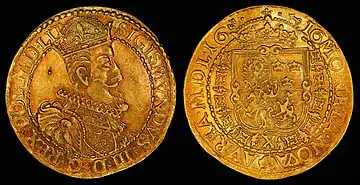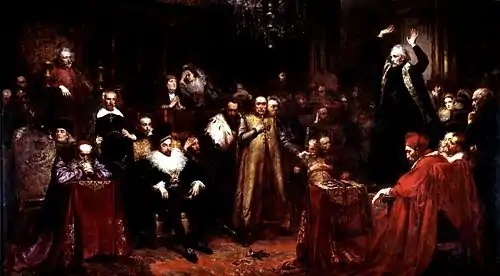Sigismund III Vasa
Sigismund III Vasa[lower-alpha 1] (20 June 1566 – 30 April 1632 N.S.), also known as Sigismund III of Poland, was King of Poland, Grand Duke of Lithuania and monarch of the united Polish–Lithuanian Commonwealth from 1587 to 1632 as well as King of Sweden and Grand Duke of Finland from 1592 to 1599.
| Sigismund III | |||||
|---|---|---|---|---|---|
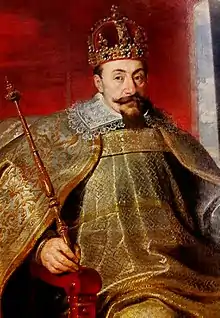 Sigismund III Vasa by Pieter Soutman | |||||
| King of Poland Grand Duke of Lithuania | |||||
| Reign | 18 September 1587 – 19 April 1632 | ||||
| Coronation | 27 December 1587 | ||||
| Predecessor | Anna Jagiellon and Stephen Báthory | ||||
| Successor | Władysław IV | ||||
| King of Sweden Grand Duke of Finland | |||||
| Reign | 17 November 1592 – 24 July 1599 | ||||
| Coronation | 19 February 1594 | ||||
| Predecessor | John III | ||||
| Successor | Charles IX | ||||
| Born | 20 June 1566 Gripsholm, Mariefred, Sweden | ||||
| Died | 30 April 1632 (aged 65) Warsaw, Poland | ||||
| Burial | 4 February 1633 | ||||
| Spouses | |||||
| Issue among others... | Władysław IV of Poland John II Casimir of Poland John Albert, Bishop of Warmia and Kraków Charles Ferdinand, Duke of Opole Anna Catherine Constance, Electress Palatine | ||||
| |||||
| House | Vasa | ||||
| Father | John III of Sweden | ||||
| Mother | Catherine Jagiellon | ||||
| Religion | Roman Catholicism | ||||
| Signature |  | ||||
Sigismund was the son of John III of Sweden and his first wife Catherine Jagiellon of Poland.[1] Elected monarch of the Polish–Lithuanian Commonwealth in 1587, he sought to unify Poland and Sweden under one Catholic kingdom, and succeeded for a time in 1592 (Polish–Swedish union). After he had been deposed in Sweden by his Protestant uncle, Charles IX, he spent much of his life attempting to reclaim the Swedish throne.[1]
A pious yet erratic ruler, Sigismund attempted to hold absolute power in all his dominions. He suppressed internal opposition, strengthened the power of the Catholic Church and granted greater privileges to the Jesuits. He actively interfered in the affairs of neighbouring states; he took advantage of a period of civil unrest in Muscovy, known as the Time of Troubles, and invaded Russia, holding Moscow for two years (1610–12) and Smolensk thereafter. Sigismund's army also defeated the Ottoman forces in Moldavia (1617–21), which systematically led to the demise of Sultan Osman II. However, the Polish-Swedish conflict had a less favourable outcome. After a series of short skirmishes and wars ending in a truce, Gustavus II Adolphus of Sweden launched a campaign against the Commonwealth which resulted in the loss of Polish Livonia (Estonia and Latvia) with Riga and in Sigismund's claim to the Swedish crown.[2]
Sigismund remains a highly controversial figure in Poland. One of the country's most recognisable monarchs, he moved the country's administrative capital from Kraków to Warsaw in 1596. His long reign coincided with the Polish Golden Age, the apex in the prestige, power and economic influence of the Polish–Lithuanian Commonwealth. On the other hand, it was also during his reign that the seeds of decline surfaced which would lead to the eventual demise of the Commonwealth.[3]
He was commemorated in Warsaw by Sigismund's Column, one of the city's landmarks and the first secular monument in the form of a column in modern history.[4] It was commissioned after Sigismund's death by his son and successor, Władysław IV.
Early life
Childhood and election
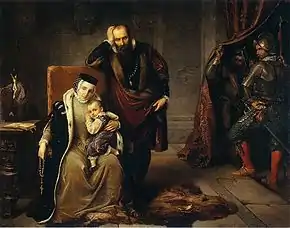
Sigismund was born on 20 June 1566 to Catherine Jagiellon and Grand Duke John of Finland at Gripsholm Castle.[5][6] The couple was being held prisoner at Gripsholm since 1563 when John staged a failed rebellion against his deranged brother Eric XIV of Sweden.[7] Despite the Protestant domination of Sweden young Sigismund was raised as a Roman Catholic.[8] His mother Catherine was the daughter of Polish king Sigismund the Old and Queen Bona Sforza of Milan, all of whom where practicing Catholics.[9] In October 1567 Sigismund and his parents were released from prison at the request of his uncle Charles.[10][11] In January 1569, Eric XIV was deposed and Sigismund's father ascended the throne of Sweden as John III.[12] From 1569 onward Sigismund was the Crown Prince of Sweden.
In 1587 Sigismund stood for election to the Polish throne after the death of Stephen Báthory.[13] His candidacy was secured by Queen Dowager Anna, Hetman Jan Zamoyski and several elite magnates who considered him a native candidate as a descendant of the Jagiellons, though the election was openly questioned and opposed by the nobles politically associated with the Zborowski family.[14][15][16] With the blessing of primate Stanisław Karnkowski and strong support from other people of influence he was duly elected ruler of the Polish–Lithuanian Commonwealth on 19 August 1587.[17] His official name and title became "by the grace of God, king of Poland, grand duke of Lithuania, ruler of Ruthenia, Prussia, Masovia, Samogitia, Livonia and also hereditary king of the Swedes, Goths and Wends"; the latter titles being a reference to the fact that he was already the Crown Prince of Sweden, and thus would lawfully succeed to the throne of Sweden upon the death of his father.[18]
Opposition to the throne
.jpg.webp)
The outcome of the election was strongly contested by factions of the Polish nobility that backed the candidacy of Archduke Maximilian III of Austria, who launched a military expedition.[19] When the news reached Sigismund in Sweden, he passed through the clutches of the Protestants, crossed the Baltic and landed in Poland on 7 October, immediately agreeing to grant royal privileges to the Sejm (parliament) in the hope of calming the opposition and settling the disputed election.[20] He was proclaimed king by Treasurer Jan Dulski on behalf of Crown Marshal Andrzej Opaliński, and after arriving in the Royal Capital City of Kraków he was crowned on 27 December at Wawel Cathedral.[21]
Ultimately, Jan Zamoyski defeated Maximilian at the Battle of Byczyna and took him prisoner.[22] At the request of Pope Sixtus V, the Archduke was then released and in turn surrendered his claim to Poland in 1589.[23] Sigismund was also successful in maintaining peace with his powerful southern neighbour by marrying Archduchess Anne of Habsburg in 1592.[24] Simultaneously, he secured an alliance with Catholic Austria against Protestant foes.[25]
When his father died, Sigismund was granted permission by the Polish Diet to claim his inheritance as the rightful King of Sweden.[26] The Swedes, who previously declared John III a Catholic conspirator and traitor, became lenient when the new monarch pledged to respect Lutheranism as the country's new state religion.[27] Sigismund was crowned at Uppsala on 19 February 1594,[28] but his promise to uphold the Protestant faith in Sweden was a deception, as demonstrated by the presence of a papal nuncio in the royal procession.[29] He appointed his uncle, Duke Charles, to rule as regent on his behalf when he returned to Poland.[30] Tensions grew promptly in Sweden as Sigismund remained a devout Roman Catholic and left the country abruptly, which made the Swedes suspicious.[31] Sigismund had the ultimate intention of reinstating Catholicism by force if necessary.[32] The Jesuits often acted as agents refuting Protestantism and regaining lost spiritual ground for Rome.[33]
Conflict with Jan Zamoyski
Resistance and intrigues

The hostility between Chancellor Jan Zamoyski and Sigismund began as soon as he arrived in Poland from Sweden to claim the crown.[34] Zamoyski, a patriotic brawler, along with other magnates were critical of the young king's liking for the Habsburg culture, certain habits and impassive cold character.[35] According to historian and writer Julian Ursyn Niemcewicz, Zamoyski was said to have exclaimed "what a mute have you brought to us" upon meeting the king in October 1587.[36][37] The Chancellor was initially supportive of Sigismund's candidacy due to his maternal lineage and connection to the royal house of Jagiellon.[38] During the first parliament sitting, the so-called Pacification Sejm, in March 1589, Zamoyski proposed extensive reforms of the electoral system; notably, he presented the idea that only a member of a local native dynasty should henceforth be eligible to the Polish throne.[39] It entailed the permanent exclusion of any Habsburg candidates.[40]
Sigismund saw a potential ally in Austria; he sought to establish a Catholic league that would actively engage in the Counter-Reformation.[41] Zamoyski openly condemned Sigismund for associating with the Habsburgs, particularly Archduke Ernest, and speculated that Ernest was to be the potential successor if Sigismund abdicated and returned to Sweden.[42] The anti-Austrian sentiment was only explicable as a circuitous attempt to traverse the Habsburg hegemony and influence in Central Europe, which Zamoyski perceived as a major threat.[43] However, the parliament immediately rejected the proposal and ruled in favour of Austria, thus also accepting a marriage between Sigismund and Anne of Habsburg.[44] Furthermore, the reestablishment of peaceful relations with Austria was dictated by the Treaty of Bytom and Będzin from March 1589 which was negotiated by Ippolito Aldobrandini, future Pope Clement VIII.[45]

At the subsequent Sejm session, assembled in March 1590, Zamoyski persuaded the gathered deputies and representatives to exclude Archduke Maximilian from future candidacy to the throne by frightening them with the bugbears of Austrian intrigues and of the incoming Turkish threat.[46] His opponents, headed by Primate Karnkowski, formed an informal confederation immediately after the Sejm rose to protest the decrees.[47] A second Sejm sitting at the end of the same year proceeded to reverse all the decrees of its predecessor.[48] Thus, the Hetmanship was suspended, the party of Maximilian was amnestied, the Zborowskis were rehabilitated, and Zamoyski's counterparts were removed from the royal court.[49] Tensions grew further over the ownership of Estonia between Sweden and Poland following the dissolution of the Livonian Order;[50] Zamoyski held Sigismund accountable for the dispute.[51]
Sigismund's leniency towards the Habsburgs also alienated some clerics; the Austrians wanted to prevent Andrew Báthory from seizing the bishopric of Kraków and succeeded in doing so by diplomatic coaxing or coercion.[52] The new papal nuncio, Annibale di Capua, a staunch Habsburg supporter, eventually convinced Sigismund to nominate Jerzy Radziwiłł after Piotr Myszkowski died on 5 April 1591.[53] Capua stressed that Andrew had not been an ordained priest and was not legally capable to become bishop.[54] The decision strained the once friendly relations between Poland and Transylvania.[55]
Peace settlement
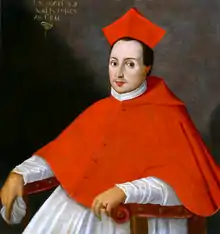

As outlined by Oskar Halecki, the king's friends were largely recruited from the higher clergy and the Jesuits, who violated the 1573 Warsaw Confederation guaranteeing religious freedoms in Poland and Lithuania.[56] As persecution loomed, political dissidents grouped and formed factions which called for adherence to the laws of the Confederation.[57] Zamoyski joined the dissidents, and, when Sigismund failed to prevent mob violence directed against non-Catholics in Vilnius and Kraków in 1591, he summoned several conventions that "demanded the guarantees of security".[58] Sigismund yielded to their demands, however, he forbade any future conventions which could destabilize the state. The prohibition did not have a lasting effect, and gatherings of dissidents continued in the following year.[59]
The opposition hoped to thwart the match with Archduchess Anne of Habsburg, who made her state entry into Kraków amidst great rejoicings at the end of May.[60] Sigismund disregarded any protest in regards to the marriage.[61] Consequently, on 1 June 1592 Zamoyski formed another confederation at Jędrzejów (Latin: Andreiow) attended by the most eminent and distinguished magnates, among them Mikołaj Zebrzydowski and Stanisław Żółkiewski.[62] At Andreiow, he allegedly exposed proof concerning a plot that would place Archduke Ernest on the throne if Sigismund was to abdicate.[63] Zamoyski's claim caused an uproar.[64]
At the sitting of the "Warsaw Inquisition Sejm" (sejm inkwizycyjny) summoned by Sigismund on 7 September[65] to inquire into all grievances and thoroughly sift the so-called "Austrian cabals", Zamoyski was once more formidable in his address. His argument against that of the monarch was so persuasive that elderly Karnkowski sided with the Chancellor and his supporters,[66] who abstained from kissing the king's hand upon arrival as the custom required.[67] Alleged letters and private correspondence between Sigismund and Ernest with the royal signature was presented as evidence.[68][69] The king rebuked these accusations; his aides attributed the falsified signature to the court scribe, who was subsequently imprisoned at Działdowo (Soldau), tortured, but pleaded not guilty.[70] The opposition extended their demands and asked for the immediate removal of all foreign dignitaries from the court, including mercenaries, which was not fully enforced.[71]
The Sejm had no definite outcome; most of the gathered nobles and diplomats dispersed as further incrimination of the sovereign proved futile and detrimental to the stability of the state.[72] There is little evidence or written works from the period concerning the terms under which the Sejm functioned or how it concluded.[73] Niemcewicz largely attributed the victory to Sigismund – the measures of the Counter-Reformation strengthened[74] and within a year many of the convention's attendees died; acquiescent nobles favourable to the king were appointed as their successors, thus making his position less vulnerable.[75] The rivalry between Sigismund and Zamoyski continued until the latter's death in 1605.[76][77]
War against Sigismund in Sweden
Tensions

.jpg.webp)
The Uppsala Resolution of 1594 dictated the rights and securities of Protestants in Sweden; it promised to uphold the Lutheran faith in the country, forbade non-Lutherans from being appointed to office or participating in the educational system and prevented Sigismund from freely raising taxes for war.[78] However, the resolution was undermined whenever possible.[79] With military backing, Sigismund installed his own commanders in Swedish castles and made them responsible directly to him.[80] He established the office of regional governor (ståthållare) and appointed Klaus Fleming as the overlord of Finland, Charles' lifelong enemy.[81] The governors served notice that they would abstain from persecuting Catholicism in their administered territories.[82] Erik Brahe, a Roman Catholic, became the governor of Sweden's capital city, Stockholm, in defiance of the 1594 charter which sparked widespread anger.[83]
On 4 August 1594 Sigismund decreed that the Swedish parliament (riksdag) had no right to function without royal consent.[84] Despite this, Charles summoned a parliament at Söderköping in autumn of 1595,[85] at which he declared himself regent and head of government, who would govern Sweden reciprocally with the Privy Council during the king's absence from the realm.[86] The Finnish nobility led by Fleming rejected this resolution and so did Sigismund's emissary who ordered him, in the name of the king, to resign.[87] Fleming sympathised with Sigismund and considered Charles a rebel.[88] In response, Charles instigated a brief revolt against Fleming among the peasants under Jaakko Ilkka in the province of Ostrobothnia, known today as the Cudgel War.[89][90]
As outlined by historian Gary Dean Peterson, Fleming might have quelled the rebellion but it was Charles who took advantage of the brutality of Fleming's men and started a successful propaganda war.[91] The prospects of Polish and Catholic domination over Sweden became uncertain when Klaus Fleming died on 13 April 1597.[92] He was succeeded by Arvid Stålarm the Younger, who did not accede to Swedish demands and awaited Charles' intervention in Finland.[93] Meanwhile, the nobility dispersed; Erik Gustafsson Stenbock, Arvid Gustafsson Stenbock, Erik Larsson Sparre, Erik Brahe and Sten Banér fled to entreat Sigismund to return and counter Charles.[94]
Civil war

In 1597, a civil war erupted[95] and Duke Charles was able to assume control over a large share of the powerful castles in Sweden, and in this manner achieved control over almost all the realm.[96] However, Finland remained loyal to Sigismund and resisted. In September 1597, he sailed for the Finnish coast and was able to take Åbo Castle in Turku, defended by Fleming's widow Ebba Stenbock, by the end of the month.[97][98] It is said that upon seeing Fleming's body lying in a coffin at the castle's chapel[99] Charles exclaimed "hadst thou now been alive, thy head would not have been in great safety."[99] Stenbock in response said "if my late husband had been alive, Your Grace would never have entered herein."[99] Charles' troops were not prepared nor strong enough to conquer or hold Finland in its entirety – they sailed back to Stockholm in October and Stålarm retook Åbo the same year.[100]
As noted by envoys, several high-ranking noblemen fighting for Sigismund's cause were instantaneously sent to the scaffold.[101] Further tensions and escalation of violence as well as Charles' unpredictable stance persuaded Sigismund to intervene.[102] Christian IV of Denmark agreed to cooperate but would not join the armed conflict.[103] The major seaports of Danzig (Gdańsk), Lübeck and Rostok were pressured to sever trade with Sweden.[104] Polish privateers began to violently attack Swedish vessels in the Baltic.[105] By February 1598 Sigismund assembled an army consisting of approximately 5,000 men.[106] On 23 July 1598 the army left Danzig (Gdańsk) with 80 transports, several warships and exiled members of the Swedish parliament.[107] Eight days later they landed in Kalmar, which surrendered without a fight.[108]
After the fall of Kalmar, Charles found himself with major trouble on his hands; the Polish Crown army attracted Swedish followers, and Stockholm, lacking military defence, was easily taken with the help of the nobility and officers of Götaland.[109] The cavalry of Uppland soon joined the royalists, and new forces were mobilised in Finland and Estonia.[110][99] Charles' troops were greater in numbers, but mostly comprised poorly-trained militias and peasants from the friendly provinces.[111]
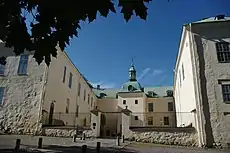
Sigismund advanced his troops towards Stångebro in Linköping where his sister Anna Vasa resided.[112] On 8 September Charles executed a premature attack on Stångebro which was quickly repelled; his force was surrounded in the night and massacred by the Poles.[113][114] Severed heads on lances and spikes startled Sigismund who ordered an end to the violence.[115] The supposed truce did not come into effect, and, on the morning of 25 September, the armies clashed once more in a major engagement at the Battle of Stångebro. The prevailing fog was instrumental at hiding troop movement; the Swedish rebels used the opportunity to take the bridges on the river Stångån when Sigismund's men were falsely led into a truce and retreated to their camp.[116] Their attempt to regroup and form a second defensive line proved futile and Charles emerged victorious as the Polish army was also cut off from supplies by superior Swedish warships.[117]
Aftermath and deposition
The peace agreement was sealed with a dinner at Linköping Castle on 28 September.[118] Both sides agreed to lay down arms and send the troops back to their home provinces, except for the king's personal guard.[119] Charles' appointments were to be recognized and a parliament was to be called to settle any disputes.[120] The king, who was under pressure, fearing for his life without his army and having realised that he had lost the political battle, fled with his sister during the coming days to Poland.[121] At the same time as the peace treaty was being signed in Linköping, conflicts were taking place in Dalarna.[122] There, a pro-Sigismund bailiff, Jacob Näf, had tried to raise up the Dalecarlians against Duke Charles.[123] Chaos ensued, Näf was executed, and the Dalecarlians set out on the so-called Neaf Campaign (1598), burning and killing down to Brunnbäck ferry. In Västergötland, Carl Carlsson Gyllenhielm, illegitimate son of Duke Charles, defeated the rebellion.[124] A number of Swedes who had sided with Sigismund, including his council supporters, were handed over to Charles as part of the peace settlement.[125] They were later killed in the Linköping Bloodbath of 1600.[126]
Sigismund was officially deposed from the throne of Sweden by a riksdag held in Stockholm on 24 July 1599.[127] He was given six[128] (or twelve depending on source)[129] months to send his son, Prince Ladislaus (Władysław) Vasa, to Sweden as his successor, under the condition that the boy would be brought up in the Protestant faith.[130] In February 1600, Duke Charles summoned the Estates of the Realm to Linköping.[131] Since Sigismund had not provided a reply, the Estates elected Duke Charles as king apparent, however he would not become Charles IX until his coronation four years later.[132] During the winter and spring of 1600, Charles also occupied the Swedish part of Estonia, as the castle commanders had shown sympathies towards Sigismund.[133] Charles' invasion of Livonia led to a series of wars with Poland, starting with the Second Polish–Swedish War.[99]
Polish affairs
Clash with England (1597)

The Ottoman Empire and England were allies of convenience against Spain under Philip II Habsburg, for whom Sigismund held sympathy.[134] While Elizabeth's armies were fighting Catholic forces in the Low Countries to prevent the Spanish from gaining secure harbours on the Channel, England also served Turkish interests by diverting Spain from dominating the Mediterranean.[135] Poland, on the other hand, was engaged in continuous skirmishes with the Turks on its southeastern flank. The good will of Poland was crucial as the country was the source of grain and timber necessary to maintain the English navy.[136] Edward Barton, Elizabeth's ambassador to the Ottoman Empire, has warned that if the Turks were to launch a campaign against Poland, England would respond.[137]
In July 1597, the Privy Council instructed Henry Billingsley, Lord Mayor of London, to arrange housing for a Polish diplomat, who would negotiate the terms of the Baltic trade.[138] To ensure Elizabeth would not find fault with the preparations, the Lord Mayor was to report the arrangements made.[139] On July 23, Paweł Działyński (recorded as Paul Dzialynski or Paul De Jaline in English historiography) arrived in London and was accommodated at the house of Sir John Spencer.[140] On July 25, Działyński was granted an audience at the palace in Greenwich.[141] Brought to the reception hall, he found Elizabeth under the canopy of state with many of her nobles and councillors in attendance.[142] As described by Robert Cecil, 1st Earl of Salisbury, the ambassador out of Poland at first seemed to be "a gentleman of excellent fashion, wit, discourse, language, and person...dressed in a long black velvet robe, well-jewelled and buttoned."[143] He presented his credentials, and kissed the Queen's hand extended to him―a gesture of royal favour, then strode to the centre of the chamber and, as outlined by Cecil, "began his oration aloud in Latin, with such a gallant countenance as in my life I never beheld."[144][145]
Działyński insultingly informed Elizabeth that Sigismund was outraged about the policy of having her vessels capture ships of Polish and Hanseatic merchants trading with the Spanish, which he found intolerable.[146] He stressed that hostilities would have commenced if the English had not rescinded her orders to interdict trade, release the captured ships, and restore the confiscated cargo or make restitution.[147] Thomas Egerton, 1st Viscount Brackley was intended provide an answer in the name of the Queen, however, Elizabeth herself rose "lionlike" and delivered her rebuke; she compared his speech to a declaration of war and manners to that of "a herald than an ambassador."[148][149] She reminded that England was instrumental in halting the Turkish attack and added "if the King [Sigismund] himself were present he would have used such language."[150][151] Sigismund emerged successful in securing trade with the Spanish Crown and with England, though the relations between the two nations became strained.[152] According to historians Kavita Mudan Finn and Valerie Schutte, William Shakespeare might have used Elizabeth's political anger at the Polish ambassador as an inspiration for Queen Margaret who employs similar strategies in the play Richard III.[153]
Zebrzydowski Rebellion (1606)

Sigismund's attempt to grasp unlimited authority resulted in the Zebrzydowski Rebellion, an armed insurrection formed in 1606 by Hetman Mikołaj Zebrzydowski, Jan Szczęsny Herburt, Stanisław Stadnicki, Aleksander Józef Lisowski and Prince Janusz Radziwiłł in Stężyca and Lublin.[154][155] It was primarily caused by the growing dissatisfaction with the monarch among the Polish szlachta and wealthy magnates. The rebels disapproved of Sigismund's efforts to weaken the diplomatic and political capabilities of the nobility and to introduce an absolute monarchy.[156] The rebellion ended in the defeat of the rebels. Despite the failure to overthrow Sigismund, the rebellion firmly established the rights and privileges of nobles in the Polish political system, confirmed the inviolability of the royal elections and religious tolerance.[157]
The Polish nobles and participants of the rebellion formed a council and outlined their demands in 67 articles.[158] They demanded dethronement for breaching the Henrician Articles and the expulsion of the Jesuits from the Polish–Lithuanian Commonwealth.[159] They further demanded that the Sejm was to appoint state officials instead of the king; that local officials should be elected and not appointed; and that the rights of Protestants should be expanded and protected. The 1607 Parliament rejected the demands. Meanwhile, the rebel nobles gathered in the town of Guzów.[160][161] In 1607 the Polish Royal Army, led by Hetman Jan Karol Chodkiewicz, was sent to pacify the rebels. A full-scale battle ensued on 5 July, with 200 casualties, which resulted in the victory of the Royalist forces.[162] By 1609 the rebellion was over. Two years after the start of the revolt, the rebellious nobles formally surrendered to the king at the 1609 meeting of the Sejm, which became known as the Pacification Sejm.[163] In return for their surrender the rebels were granted leniency.[164] Many royal supporters, including Hetman Chodkiewicz, had exacted amnesty for the rebels.[165]
The first rebellion in Polish history had sinister consequences. Royalty lost, to great extent, the moral prestige it had enjoyed... The Polish constitution was henceforth regarded as sacrosanct and the king had to renounce not only the idea of making any far-reaching changes in it, but even any reform.
Sigismund's invasion of Russia (1609–1618)
Combating heresy and giving Poland a strong and stable government were the primary goals of Sigismund. In the time of the Polish–Lithuanian Commonwealth, the Poles were a force to be reckoned with, especially their elite, heavy cavalry, most notably the Winged Hussars.[166] While the Russians were fighting among themselves in a civil war (Time of Troubles), Sigismund saw an opportunity to invade and take power, as did Sweden though they were never firmly on one side or the other.[167]
The "Time of Troubles" was a dark period in Russia's history; it began when Tsar Feodor I died in 1598, which caused internal instability and a succession crisis upon the extinction of the Rurik dynasty.[168] Further setbacks that contributed to the escalation of violence was the famine of 1601 to 1603 which killed approximately 2 million Russians. As the situation in Russia deteriorated, Sigismund enhanced Polish nobles and magnates to influence Russian boyars. The new Tsar, Boris Godunov, proved to be an ineffective ruler and died after a lengthy illness and a stroke in April 1605. He left one son, Feodor II, who succeeded him and ruled for only a few months, until he and Boris' widow were murdered by the enemies of the Godunovs in Moscow in June 1605.[169] Rumours circulated that they were murdered on the orders of king Sigismund but no real evidence of that exists. Simultaneously, various pretenders to the Russian throne appeared claiming to be Tsarevich Dmitry Ivanovich, the youngest son of Ivan the Terrible. In fact, the real Tsarevich died at the age of eight in 1591. After the fall of impostor False Dmitry I and his Polish wife Marina Mniszech (known in Russian historiography as Marinka the Witch), Vasili Ivanovich Shuysky was crowned as Vasili IV of Russia.[170]
The death of False Dmitry proved as an excuse for Sigismund to prepare an invasion. Prior invasions and raids between 1605 and 1609 were conducted by Polish nobles with the help of hired Cossacks and foreign mercenaries. Sigismund's primary intention was to destroy the Russian state in total and impose Catholicism under any condition, with the use of force if necessary.[171] Lew Sapieha, Grand Chancellor of Lithuania, who sought neutrality proposed to Boris Godunov an alliance or "eternal peace" treaty[172] between Russia and Poland, but the idea did not gain wide support and was declined.[173]

The Commonwealth army under the command of Hetman Stanisław Żółkiewski, who initially opposed to this conflict but could not disobey Sigismund's orders, crossed the border and on 29 September 1609 laid siege to Smolensk.[174] On 4 July 1610, at the Battle of Klushino, the outnumbered Polish force achieved a decisive victory over Russian troops, mostly due to the tactical competence and skill of Żółkiewski as well as the military prowess of Polish hussars.[175] The battle was a major blow to the Russians; Tsar Vasili IV was subsequently ousted by the Seven Boyars and Żółkiewski entered Moscow beginning the two-year tyrannical occupation of the Kremlin.[176] Seven Boyars proclaimed Polish prince Władysław, Sigismund's son, as the new Tsar of Russia. In June 1611 Smolensk finally fell to the Poles. Former Tsar Vasili Shuysky was transported in a wagon to Warsaw, where he paid tribute (Shuysky Tribute) to Sigismund and the Senate at the Royal Castle on 29 October 1611.[177] He eventually died in Gostynin[178] as prisoner; he was most likely poisoned as his brother died soon after. The Polish army also committed numerous atrocities while stationing in Moscow.[179][180]
In 1611, Kuzma Minin and Prince Dmitry Pozharsky formed a new army to launch an uprising against the Polish occupation.[181] Sigismund's forces withdrew from ruined Moscow in September 1612. News of the capitulation reached Sigismund on 8 December at Volokolamsk. The war continued with little military action until 1618 when the Truce of Deulino was signed, which granted Poland new territories, including the city of Smolensk.[182] The agreement marked the greatest geographical expansion of the Polish–Lithuanian Commonwealth (0,99 million km2) until the loss of Livonia in 1629.[183] However, Russia was able to retain independence and Michael Romanov was crowned Tsar in 1613.[182] This established the Romanov dynasty which ruled Russia until the February Revolution in 1917.[184]
.jpg.webp)
Sigismund's personal ambition of ruling the vast lands in the east as well as converting the populace to Catholicism ended in a fiasco. The conflict had a strong impact on Russian society and, as a consequence, the Polish-Russian relations remain tense even today.[185]
Thirty Years' War (1618–1648)
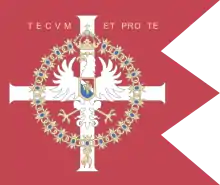
Sigismund III would have intervened in the Thirty Years' War, on the Catholic side, but for the determined opposition of the Parliament (Sejm), expressing itself in fresh insurrections and the refusal of supplies. His intervention would have taken the form of an invasion and, possibly, an occupation of Transylvania, which, under the energetic and ambitious Princes of the Protestant Houses of Bethlen and Rákóczi, was the active ally of the Sultan and equally dangerous to Habsburg Monarchy and Poland. This would result in a war that would devastate the eastern borderlands of the Polish–Lithuanian Commonwealth, known as the Kresy, and Sigismund was aware that he would not stand a chance against the Ottoman Empire, stretching from the Middle East to the Balkans.
The chief pillars of military strength in Poland, including Hetman Stanisław Żółkiewski, warmly approved of the King's policy in this respect, but it proved to be impracticable. The Parliament's mania for non-intervention went so far that it refused to grant any subsidies for the Swedish War with the disastrous consequences already recorded. Sigismund eventually decided that joining the Thirty Years' War would diminish the country's national prestige and power in the region. This, however, weakened the alliance between the Habsburg states and the Polish–Lithuanian Commonwealth.
Polish–Ottoman War (1620–21)
The Principality of Moldavia was a Polish fief since the Middle Ages and Sigismund aimed at securing that despite the growing threat from the south. With the Ottoman influence and power on the rise, the Sultan aimed at expanding the Ottoman Empire westward. Furthermore, the Ottomans favoured the fertile steppes of Moldavia, Ruthenia and "Polish Ukraine". The Ottoman–Habsburg wars, which lasted almost two centuries, were also a sign of the Sultan's desperation to rule mainland Europe. Sigismund was anxious to help Habsburgs and was promised territorial gains for Poland in return for his assistance. He sent in an army consisting of mercenaries from the wars in Russia to the Principality of Moldavia, which sparked the Polish–Ottoman War.

In 1620 the Polish forces were defeated at Cecora and Hetman Żółkiewski perished during the battle.[186] In 1621 a strong army of Ottomans, led by Osman II, advanced from Edirne towards the Polish frontier.[187] The Ottomans, following their victory at Cecora, had high hopes of conquering southern part of Polish–Lithuanian Commonwealth, including Podolia, Volhynia and parts of Lesser Poland. Approximately 160,000[188] men besieged the Khotyn Fortress in September 1621 but were defeated at the Battle of Khotyn by a Polish garrison counting no more than 50,000 soldiers.[189] During the siege Hetman Jan Karol Chodkiewicz died of exhaustion and illness in the camp.[190][191]
The Treaty of Khotyn was signed on 9 October 1621 which resulted in no territorial gain or loss, but Sigismund was to relinquish his claims on Moldavia and the Ottoman Empire was prevented from marching deep into Poland. Sultan Osman himself was not fully satisfied with the war's outcome and blamed the janissaries. His wish and plans to modernize the army, which was blamed for the defeat, were however opposed by the tradition-minded janissary units. That opposition resulted in the 1622 rebellion in which Osman II was deposed and strangled.[192]
Polish–Swedish War (1626–1629)
Following a series of conflicts between Poland and Sweden in 1600–11, 1617–18 and 1621–1625, all of which ended in a stalemate, Gustavus Adolphus invaded in 1626 to gain control over Livonia and Ducal Prussia. Sigismund, already in advanced age, continued his long-term ambition of reclaiming Sweden, which gave Gustavus Adolphus a reasonable casus belli and justification for war. Though the Polish army achieved major victories in the previous battles against Sweden, particularly at Kircholm in 1605, the very end proved to be catastrophic.

The first skirmish took place in January 1626 near Wallhof, in present-day Latvia, where the Swedish army of 4,900 men ambushed a Polish force of 2,000 men commanded by Jan Stanisław Sapieha, son of Lew Sapieha. Polish casualties were estimated at between 500 and 1000 dead, wounded and captured. According to historians, the Polish-Lithuanian commander later suffered a nervous breakdown.[193]
In May 1626 the Swedes launched an invasion of Polish Prussia. Escorted by a fleet of 125 vessels, the Swedish army of over 8,000 soldiers (including 1,000 cavalry) disembarked in Ducal Prussia near the town of Piława (Pillau). The landings were a complete surprise to the Commonwealth's defences, and despite a relatively small Swedish force, Gustavus Adolphus quickly captured 16 coastal towns, almost without a fight. Many of these towns were inhabited by Protestants who opposed devoutly Catholic Sigismund. Some towns opened their gates to the Lutheran Swedish forces whom they portrayed as liberators. The Swedish king, however, failed to capture Danzig (Gdańsk), a large and wealthy port city which maintained its own army and fleet. In preparation for his major attack on Danzig, he increased his forces to over 22,000 men. Sigismund received little to no support from his vassal, George William, Elector of Brandenburg and Duke of Prussia. Sigismund deployed an army of approximately 14,500 soldiers to fight at the Battle at Gniew against the Swedish force of 12,100 men. The fighting continued for several days until 1 October 1626 when Sigismund ordered the withdrawal of his army, and called on reinforcements from around the country. The battle, despite a tactical victory for Sweden, was a strategic blow to Gustavus Adolphus, who was unable to besiege Danzig, thus only securing the town of Gniew.[194]
At Dirschau in summer 1627 Gustavus Adolphus was seriously wounded and the Prussian campaign was suspended.[194] The wound forced the king to stay in bed until autumn, and his right arm was weakened with some fingers partially paralyzed.[195] As the major trade ports on the coast of the Baltic Sea were blocked by Swedish vessels, Sigismund decided to send a fleet of 10 ships under Arend Dickmann from Danzig to engage the Swedes at the Battle of Oliva. It was the largest naval battle fought by the Polish royal navy, which successfully defeated the enemy fleet and broke the Swedish blockade.
Although Poland emerged victorious in the final battle at Trzciana, Sigismund accepted a peace offer. The Truce of Altmark was signed on 26 September 1629 (16 September O.S.). The conditions of the truce allowed Sweden to gain control of Livonia as well as the mouth of the Vistula river and some coastal towns. The greater part of Livonia north of the Daugava River was ceded to Sweden, though Latgale, the southeastern area and Dyneburg remained under Polish rule. The Swedes received the right to the shipping tolls at ports of Polish–Lithuanian Commonwealth, which financed Sweden's involvement in the Thirty Years' War.
By the end of the 30-year Polish-Swedish conflict, Sigismund became heavily ill and was incessantly blamed for the loss of Livonia.
Synopsis of Sigismund's politics
Coat of arms, Polish–Lithuanian Commonwealth, and privy mark of Hieronim Wołłowicz, Grand Treasurer of Lithuania[196] (reverse, see file notation).
Many historians agree that Sigismund considered Poland as a tool to eventually regain the throne of Sweden. To this end he tried to strengthen his royal power and allied himself with Habsburgs and Counter-Reformation forces. His policies were opposed by many within the circles of the wealthy Polish nobility (the szlachta), most notably the chancellor Jan Zamoyski. This led to a semi-legal rebellion against the king (rokosz), known as Zebrzydowski Rebellion (1606–08), which was a response to Sigismund's attempt to introduce majority voting in place of unanimity in the Sejm. Eventually Sigismund's forces were victorious, but the rebels went unpunished. Partially in order to pacify the restless szlachta, Sigismund supported war with Muscovy (the Dimitriads, 1605–18). Although Commonwealth forces were almost constantly shuffled between wars in the East (with Muscovy), north (with Sweden) and South (with Ottomans in the Polish–Ottoman wars), Sigismund took advantage of the civil war in Russia (the Time of Troubles) and secured temporary territorial gains for the Commonwealth.[197]
While Sigismund never managed to regain the Swedish throne, his personal ambition to do so did succeed in provoking a long series of conflicts between the Commonwealth and Sweden, which was temporarily allied with Muscovy. While the Sejm managed to thwart many of the plans of Sigismund (and later of his son, Władysław), the Vasa dynasty nonetheless succeeded in partially drawing the Commonwealth into the Thirty Years' War. The conflict with Sweden, combined with wars against Ottomans and Muscovy, culminated well after Sigismund's death in the series of events known as the Swedish Deluge, which ended the Golden Age of the Polish–Lithuanian Commonwealth that spanned almost a century.
During his reign Sigismund permitted the Brandenburg Hohenzollerns to inherit Ducal Prussia. This decision later greatly strengthened the Duchy. The Commonwealth suffered a major military defeat in the Second Northern War, during the reign of Sigismund's younger son, John II Casimir. Under the terms and conditions of the Treaty of Oliva, Prussia became a sovereign state and would eventually Partition Poland, together with Austria and the Russian Empire, in the late 18th century.
Sigismund's relationship with the jesuit Piotr Skarga, the royal chaplain from his accession, and other religious leaders, served as a basis for his depiction in the famous painting by Jan Matejko, illustrating the preaching of Piotr Skarga in the presbyterium of Wawel Cathedral.[198]
Gentry, nobility and privileges

The Polish nobility of the Commonwealth had become excessively dominant, and its primary aim was to remain in power. The lower and middle classes were often exploited and heavily taxed by wealthy or influential families of that era. This created a sense of fear among citizens of towns and villages that were privately owned by nobles. Sigismund, as the Head of State, always sought to restrict the privileges of the upper classes and decrease the nobility's influence over the parliament in order to personally gain control. This caused disdain for the monarch and many rebellions occurred during his reign. These revolts, however, were all crushed by Sigismund and the nobles eventually surrendered, having achieved little. Furthermore, one of Sigismund's desires was to be admired and idolized by his subjects; the unsuccessful rebellions were significant in strengthening his influence over the people and the country's politics. The Sejm, however, was still directly responsible for the majority of the Commonwealth's affairs, most notably declaring wars and suing for peace.
The King was unable to officially declare a war if the decision was not fully approved or supported by the Sejm and the Senate. The Sejm usually consisted of approximately 600 nobles, diplomats and most influential politicians, who met annually at Warsaw or elsewhere, in order to contribute as little as possible to public needs and protest vehemently against everything they did not like or could not understand. The nobility was also in favour of absolute non-intervention in foreign affairs, as the cheapest and least troublesome policy to pursue.
The unwillingness of the Polish gentry to part with their money, especially for armaments, was entirely due to the fear that a popular monarch might curtail their privileges. Rather than run that risk, they avoided every advantageous alliance, forgoing every political opportunity, stinted their armies, starved and abandoned their generals, and even left the territories of the Commonwealth unguarded and undefended. This was the case of Livonia, with its fine seaboard and hundreds of towns and fortresses, which had temporarily fallen into the lap of Poland. It was later retaken by Sweden due to poor organization of the army and disinterest of the nobles to finance any military actions or campaigns. The regular army, on the other hand, was very effective against enemy troops, especially in Polish-occupied Ukraine (Ruthenia), where it had an almost unlimited reserve of the best raw military material. Moreover, the army was led by notable military commanders like Zamoyski, Żółkiewski, Chodkiewicz and Stanisław Koniecpolski.
Assassination attempt in Warsaw

An unsuccessful attempt on the life of the king was made on 15 November 1620. It occurred on Sunday at 9 in the morning when the monarch was to attend mass in St. John's Archcathedral in Warsaw.
Sigismund was to arrive by crossing a corridor or passage that linked the Royal Castle with the temple. When the royal procession reached the end, hidden in a nearby portal was petty nobleman Michał Piekarski armed with a war axe. The assassin previously killed a Hungarian mercenary who was standing guard and the royal cook. When the monarch reached the final steps, Piekarski leaped out and threw himself on the king, stabbing him twice, firstly in the back and then in the cheek, and striking him in the arm. However, he was not able to deliver a fatal blow due to the intervention of royal guardsmen as well as Court Marshal Łukasz Opaliński who shielded the king. Concurrently, Prince Władysław wounded the assassin on the head with a sabre. Other accounts state that no guards were present; the cortege had a casual character and the assassin was most likely overpowered by the attendees.[199]
Parishioners gathered around the pale and lifeless king, who collapsed to the ground after the incident. The guards or other attendants were able to revive him and after a medical examination the wounds were found to be non-life-threatening.[200] Chaos erupted when false rumours spread that the king had been murdered as his clothes were stained in blood. Initially, it was thought that the city was invaded by the Tatars.[200]
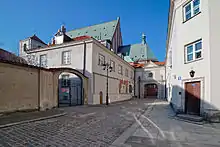
The circumstances of this attack and the assassin were known exceptionally well after the attempt, as pamphlets soon appeared on the Market Square reporting three different viewpoints on the subject, published in a total of five editions. The assassin was indeed Michał Piekarski, widely regarded as a mentally unstable melancholic, unrestrained in deeds, who as a child had suffered a head injury. Piekarski's most probable cause for the assassination was fame and recognition; the successful assassination of Henry IV in Paris (1610) by François Ravaillac served as motivation for his actions. For the appropriate moment Piekarski waited patiently 10 years. At trial he did not deny the crime he committed and heavily insulted the jury, the Court Marshal, and the monarch. He was executed in a similar manner as Ravaillac on 27 November 1620 in Warsaw, in a torture area called Piekiełko (Devil's Den or Devil's Place).[200] He was publicly humiliated, tortured and his body torn apart by horses.
Relationship with the Mennonites
Sigismund confirmed the contracts of lease made with the Mennonites and, on 20 October 1623, accorded special privileges to the Mennonite lace-makers originating from Scotland. He refused, however, to grant them any new rights or liberties. A complaint was lodged by the city council of Elbing (Elbląg) which confirmed that the Mennonites broke up marriages without having previously informed the authorities, married one another, and divided property at their pleasure. It was forbidden for the Mennonites to marry without the foreknowledge of the authorities and a penalty fine of 100 guilders was to be paid for misconduct. Nevertheless, when the Mennonites requested release from all civil handicaps, especially from military defense of the city and the court oath, he decreed on 26 April 1615 that they should perform their usual duties without interfering into the life of locals. The ruling was not enforced.
On 26 April 1626 Sigismund sent the decree orders to the magistrate of Elbing as he heard that the city eventually accepted Anabaptists and Mennonites and gave them certain privileges. Without paying tribute to the king nor obeying the decree, they carried on trade, crafts and bought properties and food from local citizens. A substantial number of residents began converting which gravely worried the Sejm.[201] Sigismund was forced to place an army of Poles and German mercenaries at the disposal of his brother-in-law, Ferdinand II of Austria, who burned and sacked the Mennonite and Hutterite villages, killing thousands of people.[201]
Decline and death

Throughout these wars King Sigismund tried to stabilize and streamline the Commonwealth government. The electoral monarchy in Poland had created a nobility with extensive powers and a great deal of division. Sigismund worked to gain more power for the king as well as to allow government business to pass with a majority of votes of the parliament rather than unanimity, which was extremely hard to achieve and meant that things often did not get done. All these actions led to a rebellion, but the King was ultimately victorious and, despite the criticism from historian Paweł Jasienica, his reign marked a period of Polish greatness.
Towards the end of his reign, Sigismund III withdrew altogether from politics and devoted himself exclusively to family matters and his interests in performing arts. Shortly after the sudden death of his second wife, Constance of Austria, Sigismund fell dangerously ill and experienced severe mental and psychological problems.[202] He became bedridden due to gout and joint pain, an affliction which was likely inherited from his grandfather Sigismund I the Old.[202] The king eventually died of a stroke on 30 April 1632 at the age of 65 in the Royal Castle in Warsaw.[203] His body was interred inside Wawel Cathedral in Kraków and he was succeeded by his son, Władysław IV.[201]
Opinion of reign and legacy
The reign of Sigismund III is widely spoken of as the beginning of the end of the Polish Golden Age.[204] He was stubborn, but a man of principle who would follow the hard but upright path rather than compromise his values for a more sure chance at success.[205] As a monarch who reigned during the Counter-Reformation he constantly worked to see the restoration of all of his subjects to the true faith embodied in the Church of Rome headed by the Pope of the Roman Catholic Church.[206] Disapproval further strengthened when Sigismund surrounded himself with the Jesuits who were appointed as advisers and ministers on the matters which did not necessarily concern religion.[207][208]
Sigismund's almost 45-year rule[209] is often criticized in Poland for his unsuccessful decisions that made the country financially vulnerable. In contrast, he is praised for the capture of Moscow and for annexing new territories into the Commonwealth, thus creating the largest country in Europe of the 16th and 17th century that lasted until its final partition in 1795. Despite being a recognizable and significant monarch in Polish historiography, the contemporary Polish society tends to remember Sigismund primarily for transferring the capital from Kraków to Warsaw in 1596.[210]
Personal life

Scholars frequently noted Sigismund's extreme piety, with some calling him a fanatic even during his lifetime.[212] Adherents, however, subtly described it as absolute devotion to religion and Roman Catholic observance, which especially drew praise from papal legates and foreign clerics who visited the court.[213] According to Paweł Mucante and Henryk Gaetano who were sent by Pope Clement VIII, "Sigismund's behaviour was comparable to that of a priest. He fervently attends mass daily, then hears choral music, sermons and orations. He fasts, and practices sexual abstinence on Wednesdays and Fridays, two days before and after confession. This large kingdom would have no schismatics, Calvinists or Lutherans if it depended on him".[214] Historian Paweł Fabisz writes that when James of England and Scotland sent a book with anti-papal connotations, Sigismund deemed the gift "vile" and threw it into the fireplace.[215]
Throughout the entire reign Sigismund maintained high etiquette and courtliness.[216] Mucante emphasized his frugality and calm nature.[217] Nevertheless, he hosted balls and held masquerades during which he would entertain guests and play the harpsichord.[218] The king was a skilled dancer and performed Polish folk dances as well as Italian dances like the saltarello and passamezzo.[219] Upon the marriage to his first wife, Anne of Austria, on 25 November 1592 he ordered a themed masquerade on Kraków's Main Market Square and, to the disbelief of his subjects, danced for the public.[220] Sigismund was also known to be physically active in his youth[221] and enjoyed occasional hunting, ice skating and frequently played football; he is widely credited for introducing and popularising the sport in Poland.[222] Members of the royal court disapproved of such activities which were perceived as improper and not worthy of a monarch, particularly the sports.[223] Much later in life he would become a more secluded man who preferred spending time with family and close advisers.[224]
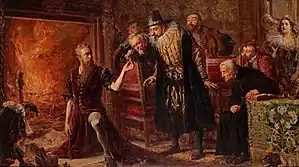
Sigismund's personal approach to internal affairs was unpredictable; he was said to have been somewhat temperamental and impetuous at times.[225] Joachim Lelewel compared his character to that of the despotic Philip II of Spain, but unlike Philip who overtly ordered persecution of non-Catholics, Sigismund was more discrete.[226] A determined and stubborn[227] man who sought to strengthen his authority, he was reluctant to participate in pointless conferences. As recalled by his close aide Albrycht Radziwill, at one meeting the king decided to sketch an owl in his notepad rather than note important advice.[228]
Sigismund held high regard for the arts and early Baroque architecture; he willingly sponsored foreign masters and engineers who came to Poland at his invitation.[229] He actively took part in the designing of façades and structural elements as well as Eucharistic objects[230] such as chalices, crucifixes, candelabra and even book covers.[231] During a visit to the Lwów Bernardine Church in 1621 he reprimanded the chief planners for making the temple seem disproportionate.[232] Sigismund was a gifted painter and craftsman; only a few of his works survive,[233] among them parts of Saint Adalbert's silver reliquary at the Cathedral in Gniezno.[234] He was also fascinated by alchemy and ancient methods of turning metals into gold; it is said he experimented with the alchemist and philosopher Michael Sendivogius.[235]
Marriages and children

On 31 May 1592 Sigismund married his first wife Anne of Austria (1573–1598), daughter of Archduke Charles II of Austria (1540–1590) and his wife Maria Anna of Bavaria (1551–1608). She was well received in Poland, despite being a Habsburg. Certain leading magnates were initially opposed to the marriage,[236] however the opinion shifted in her favour due to personal characteristics; she was known to be attentive, sharp-minded, humble, pious and kind, though of poor health.[237] The couple led a happy but introverted life. Anne was particularly hostile towards the Swedes; her attitude was shaped by an unsuccessful visit to Sweden in 1593 where she was said to have been mistreated.[238] She complained of the cold and general misery in Sweden, and fell ill there in October 1593.[239] The continuous stress arising from the unpredictable behaviour of Charles Vasa (future king Charles IX and adversary of Sigismund) also contributed to her distaste. According to an account, she gave birth in Stockholm to a baby girl named Catherine who died soonafter and was secretly buried upon their return to Poland.[240] Her health rapidly deteriorated with successive pregnancies over the next four years. She died from a puerperal fever at childbirth along with the baby boy on 10 February 1598 in Warsaw.[241][242] Following her death, Sigismund was in deep mourning; he expressed sorrow in private letters to his mother-in-law Maria Anna of Bavaria,[243] and isolated himself from trusted courtiers.[244] Anne and Sigismund had five known children during their marriage:
- Anne Marie (Polish: Anna Maria; 23 May 1593 – 9 February 1600)
- Catherine (Polish: Katarzyna; May 1594 – June 1594)
- Ladislaus (Polish: Władysław; 9 June 1595 – 20 May 1648), reigned 1632–1648 as Władysław IV
- Catherine (Polish: Katarzyna; 27 September 1596 – June 1597)
- Christopher (Polish: Krzysztof; 10 February 1598)
.jpg.webp)
Sigismund was expected to marry Anna of Tyrol in 1603, however Emperor Rudolf II did not give his consent.[245] Instead, on 11 December 1605 he wedded Constance of Austria (1588–1631), Anne's younger sister.[246] The match was condemned by nobles and clerics who previously opposed Anne and the Habsburg alliance; the match was savagely described as "incestuous".[247][248] The death of Jan Zamoyski, leader of the opposition, in June 1605 allowed for the marriage to take place without incidents.[249] Some threatened to abandon the royal court, notably Piotr Skarga.[250] The marriage further fuelled the anger of one of Sigismund's most vocal adversaries, Mikołaj (Nicholas) Zebrzydowski, who staged a rebellion in 1606.[251] The wedding ceremony and Constance's entrance into Kraków was so ostentatious it was recorded in the form of a large gouache roll painting known as rolka sztokholmska, now housed in Sweden.[252] Like her sister, Constance was well-educated and religious; she attended mass two to four times a day.[253] She was also a good mother, who particularly cared for her stepson, Władysław, even in his twenties.[254] On the other hand, Constance approved of her husband's struggle for absolute power; she maintained considerable influence over Sigismund and the senators. To the general public she appeared cold, strait-laced, intolerant and even antisemitic; in 1626 she forbade the Jews to settle in the town of Żywiec which she privately owned and administered.[255] Under her patronage, Austro-German culture as well as Spanish fashion flourished at the court.[256] Constance died on 10 July 1631 from a heat stroke she suffered after attending mass on the Feast of Corpus Christi weeks earlier.[257] Her sudden death was a blow to Sigismund who never recovered and died just nine months later.[258] They had seven children:
- John Casimir (Polish: Jan Kazimierz; 25 December 1607 – 14 January 1608)
- John Casimir (Polish: Jan Kazimierz; 22 March 1609 – 16 December 1672), reigned 1648–1668 as John II Casimir
- John Albert (Polish: Jan Albert/Olbracht; 25 May 1612 – 22 December 1634)
- Charles Ferdinand (Polish: Karol Ferdynand; 13 October 1613 – 9 May 1655)
- Alexander Charles (Polish: Aleksander Karol; 4 November 1614 – 19 November 1634)
- Anna Constance (Polish: Anna Konstancja; 26 January 1616 – 24 May 1616)
- Anna Catherine Constance (Polish: Anna Katarzyna Konstancja; 7 August 1619 – 8 October 1651), the first wife of Philip William, Elector Palatine.
Gallery
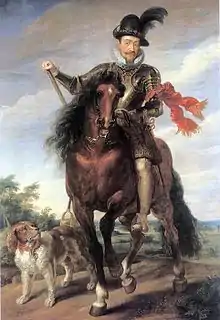 Equestrian portrait of king Sigismund III Vasa by Peter Paul Rubens
Equestrian portrait of king Sigismund III Vasa by Peter Paul Rubens False Dmitriy I takes an oath of allegiance to Sigismund III, by Nikolai Nevrev (1874)
False Dmitriy I takes an oath of allegiance to Sigismund III, by Nikolai Nevrev (1874)_02.JPG.webp) Statue of King Sigismund III on top of Sigismund's Column in Warsaw
Statue of King Sigismund III on top of Sigismund's Column in Warsaw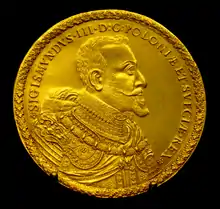 A 40-ducat coin depicting King Sigismund III Vasa, 1621
A 40-ducat coin depicting King Sigismund III Vasa, 1621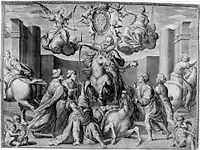 Apotheosis of Sigismund after his victory over the Turks at Khotyn in 1621
Apotheosis of Sigismund after his victory over the Turks at Khotyn in 1621 Mater Dolorosa painted by Sigismund in the 1620s, based on works by Gortzius Geldorp
Mater Dolorosa painted by Sigismund in the 1620s, based on works by Gortzius Geldorp Facade relief on the Golden House in Gdańsk
Facade relief on the Golden House in Gdańsk
Ancestry
| Ancestors of Sigismund III Vasa[259] | |||||||||||||||||||||||||||||||||||||||||||||||||||||||||||||||||||||||||||||||||||||||||||||||||||||||||||||||||||||||||||||||||||||||||||||||||||||||||||||||||||||||||||||||||||||||||||||||||||||||||||||||||||||||||||||||||||||||||||||||||||||||||||||||||||||||||||||||||||||||||
|---|---|---|---|---|---|---|---|---|---|---|---|---|---|---|---|---|---|---|---|---|---|---|---|---|---|---|---|---|---|---|---|---|---|---|---|---|---|---|---|---|---|---|---|---|---|---|---|---|---|---|---|---|---|---|---|---|---|---|---|---|---|---|---|---|---|---|---|---|---|---|---|---|---|---|---|---|---|---|---|---|---|---|---|---|---|---|---|---|---|---|---|---|---|---|---|---|---|---|---|---|---|---|---|---|---|---|---|---|---|---|---|---|---|---|---|---|---|---|---|---|---|---|---|---|---|---|---|---|---|---|---|---|---|---|---|---|---|---|---|---|---|---|---|---|---|---|---|---|---|---|---|---|---|---|---|---|---|---|---|---|---|---|---|---|---|---|---|---|---|---|---|---|---|---|---|---|---|---|---|---|---|---|---|---|---|---|---|---|---|---|---|---|---|---|---|---|---|---|---|---|---|---|---|---|---|---|---|---|---|---|---|---|---|---|---|---|---|---|---|---|---|---|---|---|---|---|---|---|---|---|---|---|---|---|---|---|---|---|---|---|---|---|---|---|---|---|---|---|---|---|---|---|---|---|---|---|---|---|---|---|---|---|---|---|---|---|---|---|---|---|---|---|---|---|---|---|---|---|---|---|---|
| |||||||||||||||||||||||||||||||||||||||||||||||||||||||||||||||||||||||||||||||||||||||||||||||||||||||||||||||||||||||||||||||||||||||||||||||||||||||||||||||||||||||||||||||||||||||||||||||||||||||||||||||||||||||||||||||||||||||||||||||||||||||||||||||||||||||||||||||||||||||||
See also
- History of Poland (1569–1795)
- History of Sweden (1523–1611)
- Unions of Sweden
- House of Vasa
- Urszula Meyerin – mistress of Sigismund III
Notes
-
- Polish: Zygmunt III Waza, Swedish: Sigismund, Lithuanian: Žygimantas Vaza, Finnish: Sigismund
References
Bibliography
- Besala, Jerzy (2009). Najsłynniejsze miłości królów polskich (in Polish). Bellona. ISBN 9788311115996. Retrieved 6 January 2021.
- Bulgarin, Ḟaddej (1857). Dymitr Samozwaniec. Obrazy historyczne z wieku XVII. 1. Sanok: Pollak. Retrieved 9 January 2021.
- Cynarski, Stanisław (1988). Zygmunt August (in Polish). Polska: Zakład Narodowy im. Ossolińskich (Ossolineum). ISBN 9788304026704. Retrieved 9 January 2021.
- Czermiński, Marcin (1907). Na Lewantyńskich i Szwedzkich Wybrzeżach (in Polish). Polska: Czas. Retrieved 9 January 2021.
- Fabisz, Paweł Władysław (1864). Wiadomość o legatach i nuncyuszach apostolskich w dawnej Polsce (1075.-1863.) (in Polish). Ostrów: Priebatsch. Retrieved 7 January 2021.
- Finn, Kavita Mudan; Schutte, Valerie (2018). The Palgrave Handbook of Shakespeare's Queens. Cham, Switzerland: Palgrave Macmillan and Springer International Publishing. ISBN 9783319745183. Retrieved 3 February 2021.
- Folger Shakespeare Library (2004). "1597" (PDF). Folgerpedia. pp. 23–24. Retrieved 3 February 2021.
- Geijer, Eric Gustave (1845). The History of the Swedes. London: Whittaker and Company. Retrieved 23 January 2021.
- Górski, Karol (2008). Zarys dziejów katolicyzmu polskiego (in Polish). Polska: Wydawn. Naukowe Uniwersytetu Mikołaja Kopernika. ISBN 9788323123118. Retrieved 9 January 2021.
- Halecki, Oskar; Reddaway, W. F.; Penson, J. H. (1950). The Cambridge History of Poland. Cambridge: University Press. ISBN 9781001288024. Retrieved 10 January 2021.
- Horn, Ildikó (2002). Báthory András [Andrew Báthory] (in Hungarian). Új Mandátum. ISBN 963-9336-51-3.CS1 maint: ref=harv (link)
- Janiszewska-Mincer, Barbara (1984). Rzeczpospolita Polska w latach 1600-1603; narastanie konfliktu między Zygmuntem III Wazą a stanami (in Polish). Bydgoszcz: Wydawn. Uczelniane Wyższej Szkoły Pedagogicznej w Bydgoszczy. Retrieved 9 January 2021.
- Karpowicz, Mariusz (1994). Matteo Castello, architekt wczesnego baroku (in Polish). Polska: Neriton. ISBN 9788390240701. Retrieved 8 January 2021.
- Komasara, Irena (1994). Książka na dworach Wazów w Polsce (in Polish). Polska: Ossolineum. ISBN 9788304041844. Retrieved 8 January 2021.
- Koskinen, Ulla (2016). Aggressive and Violent Peasant Elites in the Nordic Countries, C. 1500-1700. Springer International Publishing. ISBN 9783319406886. Retrieved 14 January 2021.
- Larned, Josephus Nelson; Reiley, Allan Campbell (1895). History for Ready Reference, from the Best Historians, Biographers, and Specialists: Nicæa-Tunis. United States: C. A. Nichols Company. Retrieved 23 January 2021.
- Lechicki, Czesław (1932). Mecenat Zygmunta III i życie umysłowe na jego dworze (in Polish). Polska: Kasa im. Mianowskiego. Retrieved 8 January 2021.
- Lelewel, Joachim (1845). Historiczna parallela Hispanii z Polską w wieku XVI., XVII., XVIII. Wydanie drugie (in Polish). Poznań: Stefański. Retrieved 8 January 2021.
- Lerski, Halina (19 January 1996). Historical Dictionary of Poland, 966-1945. ABC-CLIO. ISBN 9780313034565. Retrieved 6 January 2021.
- Miłobędzki, Adam (1980). Dzieje sztuki polskiej: Architektura polska XVII wieku (in Polish). Polska: Panstwowe Wydawnictwo Naukowe. Retrieved 8 January 2021.
- Morawska, Katarzyna (2014). Renesans (in Polish). Sutkowski Edition. Retrieved 8 January 2021.
- Morawski, Teodor (1877). Dzieje Narodu Polskiego W Krótkości Zebrane; Królowie Obieralni (in Polish). 3. Poznań: Żupański. Retrieved 2 February 2021.
- Muzeum Narodowe w Szczecinie (1986). Materiały zachodniopomorskie (in Polish). 32. Szczecin: Muzeum Narodowe. Retrieved 9 January 2021.
- Niemcewicz, Julian Ursyn; Turowski, Kazimierz Józef (1860). Dzieje panowania Zygmunta III. 1. Kraków: Czas. Retrieved 10 January 2021.
- Ochmann-Staniszewska, Stefania (2006). Dynastia Wazów w Polsce (in Polish). Poland: Wydawnictwo Naukowe PWN. ISBN 9788301145842. Retrieved 6 January 2021.
- Orgelbrand, Samuel (1861). Encyklopedia Powszechna (in Polish). 7. Warszawa: Orgelbrand. Retrieved 2 February 2021.
- Pawłowska-Kubik, Agnieszka (2019). Rokosz sandomierski 1606–1609. Rzeczpospolita na politycznym rozdrożu (in Polish). Poland: Wydawnictwo Naukowe Uniwersytetu Mikołaja Kopernika. ISBN 9788323142850. Retrieved 6 January 2021.
- Peterson, Gary Dean (2014). Warrior Kings of Sweden. The Rise of an Empire in the Sixteenth and Seventeenth Centuries. McFarland, Incorporated, Publishers. ISBN 9781476604114. Retrieved 14 January 2021.
- Piasecki, Paweł (1870). Kronika P. Piaseckiego Biskupa Przemyślskiego (in Polish). Kraków: Uniwersytet Jagielloński (Jagiellonian University). Retrieved 7 January 2021.
- Piwarski, Kazimierz (1961). Szkice z dziejów papiestwa (in Polish). Polska: Książka i Wiedza. Retrieved 9 January 2021.
- Podhorodecki, Leszek (1978). Stanisław Koniecpolski ok. 1592–1646 (in Polish). Warszawa: Wydawnictwo Ministerstwa Obrony Narodowej. Retrieved 9 March 2011.CS1 maint: ref=harv (link)
- Podhorecki, Leszek (1988). Stanisław Żółkiewski (in Polish). University of Michigan & Ludowa Spółdzielnia Wydawnicza. p. 306. ISBN 9788320540826. Retrieved 6 January 2021.
- Rastawiecki, Edward (1857). Słownik malarzów polskich, tudzież obcych w Polsce osiadłych, lub czasowo w niej przebywających (in Polish). Warszawa: Orgelbrand. Retrieved 7 January 2021.
- Roberts, Michael (1953). 1611-1626. Longmans. Retrieved 24 January 2021.
- Rocznik krakowski (in Polish). 51. Kraków: Wydawn. Tow. Miłośników Historii i Zabytków Krakowa. 1987. Retrieved 8 January 2021.
- Siarczyński, Franciszek (1828). Obraz wieku panowania Zygmunta III. Króla Polskiego i Szwedzkiego: zawieraiący opis osób żyiących pod jego panowaniem, znamienitych przez swe czyny pokoiu i woyny, cnoty lub występki dzieła piśmienne, zasługi użyteczne i cele sztuki (in Polish). Poznań: Nowa Księgarnia. Retrieved 16 November 2016 – via Google Books.
- Starźa, Józef Aleksander (1851). Stanisław Żółkiewski; obraz historyczny z czasów Stefana i Zygmunta III (in Polish). 1. Berlin: Behr. Retrieved 3 February 2021.
- Szujski, Józef (1894). Dzieła Józefa Szujskiego. Dzieje Polski (in Polish). 3. Kraków: Szujski-Kluczycki. Retrieved 9 January 2021.
- Tyszkiewicz, Count Eustachy (1846). Listy o Szwecji pisał E. Tyszkiewicz (in Polish). 1. Vilnius (Wilno): Zawadzki. Retrieved 9 January 2021.
- Varvounis, Miltiades (2016). Made in Poland: The Women and Men Who Changed the World. UK: Xilibris. ISBN 9781524596644. Retrieved 8 January 2021.
- Wdowiszewski, Zygmunt (2005). Genealogia Jagiellonów i Domu Wazów w Polsce (in Polish). Avalon. ISBN 9788391849729. Retrieved 6 January 2021.
- Wisner, Henryk (1989). Rokosz Zebrzydowskiego (in Polish). Poland: Krajowa Agencja Wydawnicza. ISBN 9788303026163. Retrieved 6 January 2021.
Inline citations
- "Sigismund III Vasa". Retrieved 30 October 2016.
- "Sigismund III Vasa - king of Poland and Sweden". Retrieved 30 October 2016.
- https://histmag.org/Czy-Zygmunt-III-Waza-zasluzyl-na-nieslawe-cz.-1-7680
- "Kolumna Zygmunta III Wazy w Warszawie". Culture.pl. Retrieved 11 April 2019.
- Fabisz 1864, p. 188
- Rastawiecki 1857, p. 95
- Tyszkiewicz 1846, pp. 85–86
- Fabisz 1864, p. 188
- Fabisz 1864, p. 188
- Tyszkiewicz 1846, p. 87
- Cynarski 1988, p. 176
- Ingvar Andersson in Erik XIV Wahlström & Widstrand 1979 ISBN 91-46-13566-9 pp. 263 & 265
- Fabisz 1864, p. 188
- Fabisz 1864, p. 189
- Oskar Halecki; W: F. Reddaway; J. H. Penson. The Cambridge History of Poland. CUP Archive. pp. 452–453. ISBN 978-1-00-128802-4.
- "Zygmunt III Waza nie mógł liczyć na ciepłe przyjęcie ze strony polskich elit. Podczas koronacji nazwano go niemotą i diabłem". TwojaHistoria.pl. Retrieved 11 April 2019.
- Fabisz 1864, p. 188
- Bulgarin 1857, p. 78
- Szujski 1894, p. 139
- Szujski 1894, p. 140
- Szujski 1894, p. 144
- pisze, Przemek (3 July 2013). "Bitwa pod Byczyną. Zamoyski upokarza Habsburgów i gwarantuje tron Zygmuntowi III - HISTORIA.org.pl - historia, kultura, muzea, matura, rekonstrukcje i recenzje historyczne". Retrieved 16 November 2016.
- "Bitwa pod Byczyną była ważniejsza od słynnej bitwy pod Wiedniem". 19 February 2016. Retrieved 16 November 2016.
- Szujski 1894, pp. 155–157
- Szujski 1894, pp. 155–157
- Szujski 1894, pp. 162–163
- Janiszewska-Mincer 1984, p. 12
- Szujski 1894, pp. 163
- "Koronacja Zygmunta III Wazy na króla Szwecji - Muzeum Historii Polski". Retrieved 16 November 2016.
- Czermiński 1907, p. 218
- Muzeum Narodowe w Szczecinie 1986, p. 386
- Górski 2008, p. 206
- Piwarski 1961, p. 92
- Szujski 1894, p. 143
- Szujski 1894, p. 143
- Niemcewicz & Turowski 1860, p. 68
- Szujski 1894, p. 143
- Szujski 1894, p. 150
- Szujski 1894, p. 150
- Szujski 1894, p. 150
- Szujski 1894, p. 151
- Szujski 1894, p. 151
- Szujski 1894, p. 150
- Szujski 1894, p. 150
- Szujski 1894, pp. 146–149
- Szujski 1894, p. 154
- Szujski 1894, p. 154
- Szujski 1894, p. 155
- Szujski 1894, p. 155
- Niemcewicz & Turowski 1860, pp. 56–57
- Szujski 1894, p. 144
- Horn 2002, p. 139.
- Horn 2002, pp. 148, 150–151.
- Horn 2002, pp. 150–151.
- Horn 2002, p. 160.
- Halecki, Reddaway & Penson 1950, p. 456
- Halecki, Reddaway & Penson 1950, p. 456
- Halecki, Reddaway & Penson 1950, p. 456
- Halecki, Reddaway & Penson 1950, p. 456
- Halecki, Reddaway & Penson 1950, p. 456
- Halecki, Reddaway & Penson 1950, p. 456
- Szujski 1894, p. 157
- Halecki, Reddaway & Penson 1950, p. 456
- Halecki, Reddaway & Penson 1950, p. 456
- Szujski 1894, p. 157
- Halecki, Reddaway & Penson 1950, p. 456
- Szujski 1894, p. 158
- Szujski 1894, p. 159
- Niemcewicz & Turowski 1860, p. 130
- Niemcewicz & Turowski 1860, pp. 130–131
- Niemcewicz & Turowski 1860, p. 131
- Niemcewicz & Turowski 1860, pp. 131–132
- Niemcewicz & Turowski 1860, p. 132
- Szujski 1894, p. 161
- Niemcewicz & Turowski 1860, p. 132
- Szujski 1894, p. 189
- Niemcewicz & Turowski 1860, pp. 267–268
- Peterson 2014, p. 102
- Peterson 2014, p. 102
- Peterson 2014, p. 102
- Peterson 2014, p. 102
- Peterson 2014, p. 102
- Peterson 2014, p. 102
- Peterson 2014, p. 103
- Koskinen 2016, p. 72
- Peterson 2014, p. 103
- Peterson 2014, p. 104
- Peterson 2014, p. 104
- Frost, R.I., 2000, The Northern Wars, 1558–1721, Harlow: Pearson education Limited, ISBN 9780582064294
- Peterson 2014, p. 104
- Peterson 2014, p. 104
- Peterson 2014, p. 104
- Peterson 2014, p. 104
- Peterson 2014, p. 104
- Larned & Reiley 1895, p. 2821
- Geijer 1845, p. 193
- Geijer 1845, p. 193
- Peterson 2014, p. 104
- Frost, R.I., 2000, The Northern Wars, 1558–1721, Harlow: Pearson Education Limited, ISBN 9780582064294
- Peterson 2014, p. 104
- Geijer 1845, p. 193
- Geijer 1845, p. 193
- Peterson 2014, p. 105
- Peterson 2014, p. 105
- Peterson 2014, p. 105
- Geijer 1845, p. 194
- Peterson 2014, p. 105
- Peterson 2014, p. 105
- Peterson 2014, p. 105
- Peterson 2014, p. 105
- Geijer 1845, p. 193
- Peterson 2014, p. 105
- Peterson 2014, p. 105
- Geijer 1845, p. 194
- Geijer 1845, p. 194
- Peterson 2014, p. 106
- Peterson 2014, p. 106
- Geijer 1845, p. 195
- Geijer 1845, p. 195
- Geijer 1845, p. 195
- Geijer 1845, p. 195
- Roberts 1953, p. 121
- Roberts 1953, p. 121
- Roberts 1953, p. 121
- Geijer 1845, p. 195
- Peterson 2014, p. 106
- Peterson 2014, p. 107
- Geijer 1845, p. 195
- Peterson 2014, p. 107
- Geijer 1845, p. 195
- Peterson 2014, p. 107
- Peterson 2014, p. 107
- Peterson 2014, p. 107
- Orgelbrand 1861, p. 852
- “The Spanish Armada and the Ottoman Porte”, in the English Historical Review, vol. 8 (1893), pp. 439–66.
- Starźa 1851, pp. 129-130
- Starźa 1851, pp. 129-130
- Folger Shakespeare Library 2004, p. 23
- Folger Shakespeare Library 2004, p. 23
- Folger Shakespeare Library 2004, p. 23
- Folger Shakespeare Library 2004, p. 24
- Folger Shakespeare Library 2004, p. 24
- Folger Shakespeare Library 2004, p. 24
- Folger Shakespeare Library 2004, p. 24
- Finn & Schutte 2018, pp. 187
- Morawski 1877, p. 172
- Morawski 1877, p. 172
- Folger Shakespeare Library 2004, p. 24
- Morawski 1877, p. 172
- Folger Shakespeare Library 2004, p. 24
- Morawski 1877, p. 172
- Niemcewicz & Turowski 1860, pp. 194–195
- Finn & Schutte 2018, pp. 187-192
- Lerski 1996, p. 684
- Pawłowska-Kubik 2019, p. 13
- Lerski 1996, p. 684
- Lerski 1996, p. 684
- Błoński, Antoni (1974). Drogi i bezdroża skarbowości polskiej XVI i pierwszej połowy XVII wieku (in Polish). Poland: Zakład Narodowy im. Ossolińskich (Ossoliński Institute). p. 67.
- Wisner 1989, p. 28
- Jaques, Tony (11 April 2019). Dictionary of Battles and Sieges: A-E. Greenwood Publishing Group. ISBN 9780313335372. Retrieved 11 April 2019 – via Google Books.
- Wisner 1989, p. 70
- Jędruch, Jacek (1982). Constitutions, Elections, and Legislatures of Poland, 1493-1977. University Press of America. p. 89. ISBN 9780819125095.
- Pawłowska-Kubik 2019, p. 9
- Wisner 1989, p. 75
- Wisner 1989, p. 75
- Sirko, Dariusz (25 February 2019). Pocket History of Poland. Rozpisani.pl. ISBN 9788395164910. Retrieved 11 April 2019 – via Google Books.
- Stone, David R. (11 April 2019). A Military History of Russia: From Ivan the Terrible to the War in Chechnya. Greenwood Publishing Group. ISBN 9780275985028. Retrieved 11 April 2019 – via Google Books.
- Gillespie, Alexander (24 August 2017). The Causes of War: Volume III: 1400 CE to 1650 CE. Bloomsbury Publishing. ISBN 9781509917662. Retrieved 11 April 2019 – via Google Books.
- Reading, Mario (11 April 2019). The Complete Prophecies of Nostradamus. Sterling Publishing Company, Inc. ISBN 9781906787394. Retrieved 11 April 2019 – via Google Books.
- Solovʹev, Sergeĭ Mikhaĭlovich (11 April 1988). History of Russia: The time of troubles : Boris Godunov and False Dmitry. Academic International Press. ISBN 9780875690988. Retrieved 11 April 2019 – via Google Books.
- Dunning, Chester S. L. (1 November 2010). Russia's First Civil War: The Time of Troubles and the Founding of the Romanov Dynasty. Penn State Press. ISBN 978-0271043715. Retrieved 11 April 2019 – via Google Books.
- Allen, W. E. D. (5 July 2017). Russian Embassies to the Georgian Kings, 1589–1605: Volumes I and II. Taylor & Francis. ISBN 9781317060406. Retrieved 11 April 2019 – via Google Books.
- Nowak, Andrzej (11 April 2019). History and Geopolitics: A Contest for Eastern Europe. PISM. ISBN 9788389607287. Retrieved 11 April 2019 – via Google Books.
- Budnik, Ruslan (19 June 2018). "The Stubborn 3 Year Siege of Smolensk". Retrieved 11 April 2019.
- "Battle of Klushino, 4 July 1610". www.historyofwar.org. Retrieved 11 April 2019.
- FRANCIS, AZRA DANIEL (1 October 2013). SHAKESPEARE'S WORLD. Author House. ISBN 9781491819494. Retrieved 11 April 2019 – via Google Books.
- Cristini, Luca Stefano (20 March 2018). Uniforms of Russian army in the era of ancient Tzar: From the Reign of Vasili IV to Michael I, Alexis, Feodor III during the XVII th century. Soldiershop Publishing. ISBN 9788893273336. Retrieved 11 April 2019 – via Google Books.
- "Gostynin Castle Church, Gostynin, Poland - SpottingHistory.com". www.spottinghistory.com. Retrieved 11 April 2019.
- Shubin, Daniel H. (11 April 2019). Tsars and Imposters: Russia's Time of Troubles. Algora Publishing. ISBN 9780875866888. Retrieved 11 April 2019 – via Google Books.
- "Obsadzenie Kremla przez załogę polską - Muzeum Historii Polski". muzhp.pl. Retrieved 11 April 2019.
- Treadgold, Donald W. (1973). Russia, 1472–1917. Cambridge University Press. p. 51.
- "Deulino Truce of 1618". TheFreeDictionary.com. Retrieved 11 April 2019.
- Cooper, J. P. (20 December 1979). The New Cambridge Modern History: Volume 4, The Decline of Spain and the Thirty Years War, 1609-48/49. CUP Archive. ISBN 9780521297134. Retrieved 11 April 2019 – via Google Books.
- "The Romanovs - Western Civilization". courses.lumenlearning.com. Retrieved 11 April 2019.
- Ransel, David L.; Shallcross, Bozena (15 June 2005). Polish Encounters, Russian Identity. Indiana University Press. ISBN 0253110548. Retrieved 4 February 2019 – via Google Books.
- "Bitwa pod Cecorą". Nowa Strategia. Retrieved 11 April 2019.
- A ́goston, Ga ́bor; Masters, Bruce Alan (21 May 2010). Encyclopedia of the Ottoman Empire. Infobase Publishing. ISBN 9781438110257. Retrieved 11 April 2019 – via Google Books.
- "Encyklopedya polska". Nakl. Polskiej Akademii Umiejetnosci; skl. gl. w ksieg.: Gebethner i Wolff. 11 April 2019. Retrieved 11 April 2019 – via Google Books.
- "Zamek w Chocimiu - malownicza twierdza na prawym brzegu Dniestru". 23 October 2017. Retrieved 11 April 2019.
- "Jan Karol Chodkiewicz - Polish general". Encyclopedia Britannica. Retrieved 11 April 2019.
- "Jan Karol Chodkiewicz". PolskieRadio.pl. Retrieved 11 April 2019.
- "Osman II - Ottoman sultan". Encyclopedia Britannica. Retrieved 11 April 2019.
- Podhorodecki, Leszek (1985). Rapier i koncerz: z dziejów wojen polsko-szwedzkich. Warsaw: Książka i Wiedza. ISBN 83-05-11452-X.
- "GMT GAMES: Gustav Adolf the Great: With God and Victorious Arms". www.gmtgames.com. Retrieved 11 April 2019.
- Podhorodecki (1978), pp. 222.
- Cuhaj, George S., ed. (2009). Standard Catalog of World Gold Coins 1601–Present (6 ed.). Krause. p. 996. ISBN 978-1-4402-0424-1.
- "Sigismund III". Retrieved 5 November 2017.
- "Kazanie Skargi według Jana Matejki - Grójec". Retrieved 5 November 2017.
- "Piekarski". kuriergalicyjski.com. Retrieved 30 April 2019.
- "Zamach na króla Zygmunta III Wazę". Retrieved 30 October 2016.
- "Sigismund III Vasa, King of Poland (1566-1632) - GAMEO". Retrieved 30 October 2016.
- "Zygmunt III Waza. Najbardziej schorowany i zniedołężniały król Polski?". CiekawostkiHistoryczne.pl.
- Rastawiecki 1857, p. 95
- "Prószyński i S-ka". www.proszynski.pl. Retrieved 5 November 2017.
- "Czy Zygmunt III Waza zasłużył na niesławę? - Histmag.org". Retrieved 5 November 2017.
- "Reformacja i Kontrreformacja w Polsce - Ściągi, wypracowania, lektury - Bryk.pl". www.bryk.pl. Retrieved 5 November 2017.
- Piasecki 1870, p. LX
- Piasecki 1870, p. LXIII
- "TOP10: Najdłużej panujący polscy królowie". 14 September 2013. Retrieved 5 November 2017.
- "Zygmunt III Waza (1566-1632)". Retrieved 5 November 2017.
- Marcin Latka. "Design for the silver reliquary of Saint Stanislaus in the Wawel Cathedral". artinpl. Retrieved 3 August 2019.
- Piasecki 1870, p. LXIII
- Fabisz 1864, p. 189
- Fabisz 1864, p. 189
- Fabisz 1864, p. 189
- Fabisz 1864, p. 189
- Fabisz 1864, p. 189
- Morawska 2014, p. 67
- Rocznik krakowski 1987, p. 34
- Rocznik krakowski 1987, p. 33
- Piasecki 1870, p. LXIV
- Piasecki 1870, p. LXIV
- Piasecki 1870, p. LXIV
- "Dziwactwa i sekrety władców Polski". Onet Wiadomości. 30 September 2013. Retrieved 12 April 2019.
- Lechicki 1932, p. 29
- Lelewel 1845, p. 16
- Lelewel 1845, p. 16
- Rastawiecki 1857, p. 97
- Miłobędzki 1980, p. 115
- Lechicki 1932, p. 179
- Komasara 1994, p. 215
- Karpowicz 1994, p. 37
- Rastawiecki 1857, p. 96
- Jolanta Talbierska, Grafika XVII wieku w Polsce. Funkcje, ośrodki, artyści, dzieła, Warszawa 2011, s. 32
- Varvounis 2016
- Podhorecki 1988, p. 306
- Besala 2009, pp. 145–146
- Besala 2009, pp. 151–154
- Besala 2009, p. 152
- Besala 2009, p. 154
- Besala 2009, p. 160
- Ochmann-Staniszewska 2006, p. 128
- Besala 2009, p. 160
- Besala 2009, p. 161
- Besala 2009, p. 168
- Besala 2009, pp. 173
- Besala 2009, p. 171
- Piasecki 1870, p. LXV
- Besala 2009, pp. 171–172
- Besala 2009, p. 171
- Besala 2009, p. 174
- Besala 2009, p. 173
- Besala 2009, p. 179
- Besala 2009, p. 180
- Buchen, Tim (August 2020). Antisemitism in Galicia. Berghahn Books. p. 50. ISBN 9781789207712.
- Besala 2009, pp. 182–183
- Besala 2009, p. 204
- Besala 2009, pp. 206–207
- Wdowiszewski 2005
Further reading
- David Stone, The Polish Lithuanian State, 1386-1795 (University of Washington 2001).
- Frost, R. I., 2000, The Northern Wars, 1558–1721, Harlow: Pearson Education Limited, ISBN 9780582064294.
- Janusz Tazbir: Historia kościoła katolickiego w Polsce 1460–1795. Warsaw: 1966, p. 91.
- Jolanta Talbierska, Grafika XVII wieku w Polsce. Funkcje, ośrodki, artyści, dzieła, Warsaw 2011, p. 32.
- Stanisław Rosik, Przemysław Wiszewski: Poczet polskich królów i książąt. p. 927.
- Stanisław Rosik, Przemysław Wiszewski, Poczet polskich królów i książąt, p. 929.
- Stanisław Rosik, Przemysław Wiszewski, Wielki Poczet polskich królów i książąt, Wrocław 2006, p. 923.
- Warszawa w latach 1526–1795, Warsaw 1984 ISBN 83-01-03323-1, p. 13.
External links
| Wikisource has original works written by or about: Sigismund III Vasa |
| Wikimedia Commons has media related to Sigismund III of Poland. |
Sigismund III Vasa Born: 20 June 1566 Died: 30 April 1632 | ||
| Regnal titles | ||
|---|---|---|
| Vacant Title last held by Anna and Stephen |
King of Poland Grand Duke of Lithuania 1587–1632 |
Vacant Title next held by Władysław IV |
| Preceded by John III |
King of Sweden Grand Duke of Finland 1592–1599 |
Vacant Title next held by Charles IX |
| Titles in pretence | ||
| Preceded by Anna Jagiellon |
Brienne claim 1596-1632 |
Succeeded by Władysław IV Vasa |
| Loss of title Deposed by Charles IX |
— TITULAR — King of Sweden 1599-1632 | |

